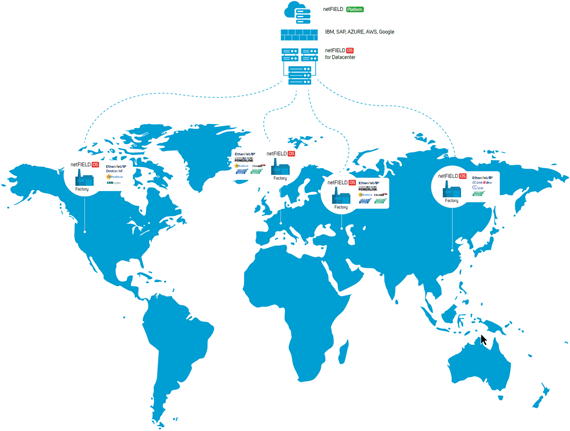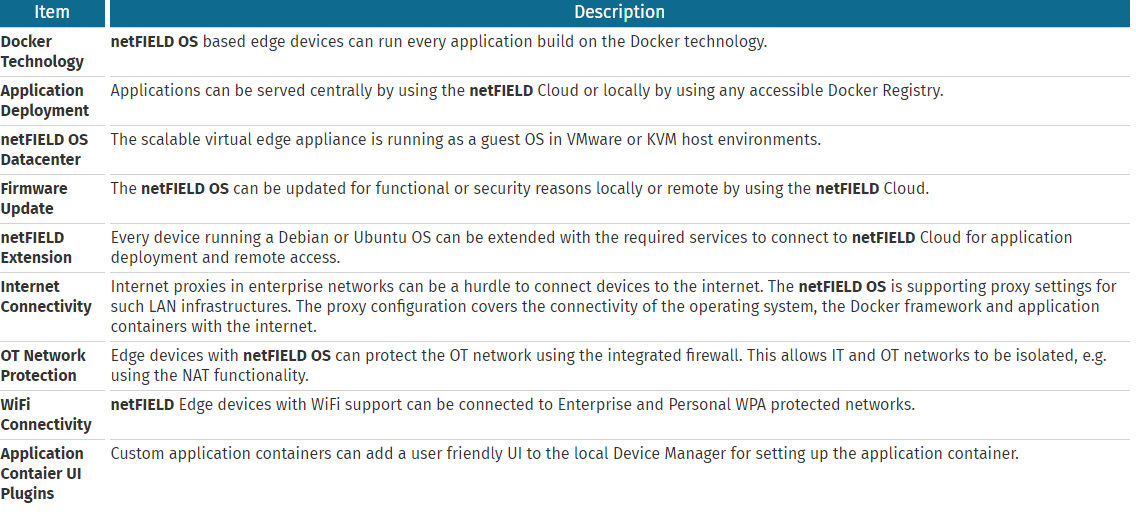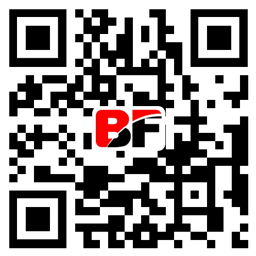Hilscher netFIELD OS is a lean and secure operating system that makes it easy to program, deploy, connect edge devices. Hilscher netFIELD OS extends the Linux kernel with software libraries to securely connect operation technology like PLC, MES, Historians, Files or other on-premise systems with IT services like the netFIELD Cloud. Our netFIELD OS lets you innovate faster embracing container technologies managed by the netFIELD Cloud platform point or locally at the edge.
The netFIELD OS core services include the support of hardware interfaces, the network environment, secure and system logging. In order to setting up the gateway configuration, the Device Manager is providing a web interface with user profiles for access control. With the open plug-in mechanism, the functionality of the Device Manager can be extended with the help of containerized applications. The device manager can also be accessed from anywhere access function of the netFIELD cloud platform.
|
 |
|
| DEVICE MANAGER MAIN CHARACTERISTICS |
|
|
|
 Device On-Boarding to netFIELD.io Device On-Boarding to netFIELD.io
 LAN/WiFi/WAN settings LAN/WiFi/WAN settings
 Resource Monitoring Resource Monitoring
 Firewall settings (NAT, enable/disable incoming ports, port-forwarding) Firewall settings (NAT, enable/disable incoming ports, port-forwarding)
 Network attached storage access (iSCSI Targets, NFS) Network attached storage access (iSCSI Targets, NFS)
 Firmware update Firmware update
|
|
|
|
 Private Key Infrastructure (Certificates) Private Key Infrastructure (Certificates)
 Logging Logging
 Shell access Shell access
 Plugin support for the configuration of application container Plugin support for the configuration of application container
 Remote Access to the local Device Manager UI, connected OT network devices or single services shared by devices connected to the OT network. Remote Access to the local Device Manager UI, connected OT network devices or single services shared by devices connected to the OT network.
|
|
|
|
| NETFIELD OS DATACENTER |
|
|
|
|
While netFIELD OS is used to run natively on a hardware device, netFIELD OS Datacenter is running in a virtualization environment. Since the software architecture of netFIELD OS is the same, the user will not recognize, whether OS and the Device Manager is running natively on a hardware device or virtualized as a guest on a hypervisor.
|
|
|
|
 Hardware resources of the Host system can be shared with guest systems as required Hardware resources of the Host system can be shared with guest systems as required
- CPU cores
- RAM
- Network Interfaces
- Persistent Storage
 High Availability / Reliability Strategies High Availability / Reliability Strategies
 Hardware independancy of guest applications (netFIELD OS) Hardware independancy of guest applications (netFIELD OS)
 Access to remote storage systems via NFS or iSCSI including RAID n redundancy Access to remote storage systems via NFS or iSCSI including RAID n redundancy
 Contribution to Green IT Contribution to Green IT
|
|
|
|
| TYPICAL SCENARIOS FOR NETFIELD OS DATACENTER |
|
|
|
In a distributed scenario with multible machines and/or locations a central instance of the netFIELD OS should be the interface to the netFIELD Cloud.
In this case a central running netFIELD App Platform Connector or another cloud connector (to connect Azure, AWS, or Google) may be the interface between between the enterprise network of the customer and one or more cloud providers.
The MQTT Broker can also run in this virtualized environment to receive aggregated or raw data from distributed edge devices on the machine sites.
The performance is scalable and depends from the number of datapoints as well as from the customer requirments in which time periods the data should be proceeded.
Additionally a database can store, aggregate and forward the received data as required to an IT System, the netFIELD Cloud platform or to another prefered cloud provider.
A local dashboard (e.g. provided by Node-RED) may offer an overview about the machine park condition.
|
|
|
|
The hardware featureset of the netFIELD Edge devices does not meet the requirement of the use case.
For example the Advanced Vector Extensions are required for an Application Container using KI (e.g. Tensorflow). In this case the virtual edge appliance can be used without additional effort for testing.
|
|
|
|
| NETFIELD OS CHARACTERISTICS |
|
|
|

|
|
|



